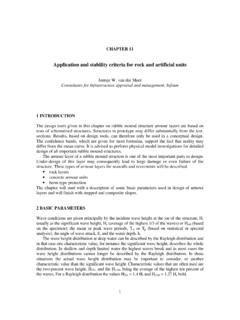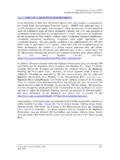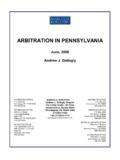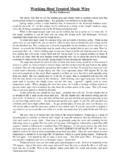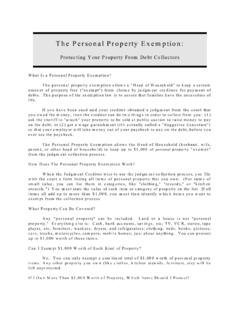Transcription of Design aspects of breakwaters and sea defences - …
1 1 5th International Short Conference on Applied Coastal Research Design aspects of breakwaters and sea defences Jentsje van der Meer1 Abstract As a keynote lecture this paper does not focus on one subject, but treats four main aspects to some depth, including new not yet published items. The first item is on definition of Design wave climate and parameters. The Design method for rock slopes, the Van der Meer formulae, have been related to the version in the new Rock Manual. A method has been given to calculate cumulative damage in an easy way. A new proposed classification of berm breakwaters has been given with new Design information on berm breakwaters . Berm breakwaters can be divided in hardly, partly and fully reshaping berm breakwater. Finally, the Wave Overtopping Simulator has been described with its main results and conclusions on strength of grass covered landward slopes of dikes.
2 Moreover, the Simulator has also been used to test vertical storm walls. The most recent innovation is the wave run-up simulation. Keywords: rock slope, berm breakwater, overtopping, run-up, stability, grass slope 1 Design wave climate, definitions and parameters For breakwater Design in this paper it is assumed that physical site conditions and data collection have been established and are available. These are mainly the bathymetry, the hydraulic boundary conditions and geotechnical investigations and data. Required Design conditions are mainly on wave heights, wave periods, water depths, water levels and tidal variation for various return periods. The conditions have to be described at the toe of the structure as these are the waves that will attack the structure and by using these conditions, the Design methods will give a fair prediction of behaviour.
3 In case the conditions change quickly in the last wave length before reaching the breakwater, it may be a good Design decision to take the conditions half a wave length or more in front of the structure, instead at the toe. Such a decision will give a Design with more safety, but will actually give a less accurate description of the behaviour of the structure. The wave height to be used is the incident significant wave height Hs at the toe of the structure. Often the spectral wave height, Hm0 = 4(m0) is taken as this wave height comes from wave climate studies. Another definition of significant wave height is the average of the highest third of the waves, H1/3. This wave height is, in principle, the wave height that should be used in the Van der Meer formulae (Van der Meer (1988-1). In deep water both definitions produce almost the same value, but situations in shallow water can lead to differences of 10-15%.)
4 In shallow water conditions one may also consider the use of the H2%, especially if stability formulae are used. In many cases, a foreshore is present on which waves can break and by which the significant wave height is reduced. There are models that in a relatively simple way can predict the reduction in energy from breaking of waves and thereby the accompanying wave height at the toe of the structure. The wave height must be calculated over the total spectrum including any long-wave energy present. Based on the spectral significant wave height, it is reasonably simple to calculate a wave height distribution and accompanying significant wave height H1/3 using the method of Battjes and Groenendijk (2000). Various wave periods can be defined for a wave spectrum or wave record. Conventional wave periods are the peak period Tp (the period that gives the peak of the spectrum) and the average period Tm (calculated from the wave record).
5 The relationship Tp/Tm usually lies between and A wave period that is used more often in recent years, certainly in wave run-up and 1 Van der Meer Consulting BV. Box 423, 8440 AK, Heerenveen, the Netherlands. SCACR Proceedings 2011 2 overtopping formulae, is the spectral period (= m-1/m0). This period gives more weight to the longer periods in the spectrum than an average period and, independent of the type of spectrum, gives similar wave run-up or overtopping for the same values of Tm-1,0 and the same wave heights. In this way, wave run-up and overtopping can be easily determined for double-peaked and "flattened" spectra, without the need for other difficult procedures. It is a wave period that has not been used a lot in breakwater Design , yet.
6 For a single peaked spectrum the ratio Tp/Tm-1,0 is close to Any formulae can actually be rewritten by the use of this ratio and, in case of bi-modal or flattened spectra, the use of Tm-1,0 will then give a more accurate prediction. Wave steepness is defined as the ratio of wave height to wave length, so = Hs/Lo. Here Lo is the deep water wave length Lo = 2 Hs/(gT2). With use of Tp the steepness becomes sop, with the mean period Tm it becomes som and finally, with the period Tm-1,0 it becomes som-1,0. The wave steepness tells something about the wave s history and characteristics. Generally a steepness of som = indicates a typical swell sea and a steepness of som = to a typical wind sea. Swell seas will often be associated with long period waves. But also wind seas may become seas with low wave steepness if the waves break on a gentle foreshore.
7 By wave breaking the wave period does not change much, but the wave height decreases. This leads to a lower wave steepness. A low wave steepness on relatively deep water means swell waves, but for depth limited locations it often means broken waves on a (gentle) foreshore. Stability formulae include often the stability number Hs/ Dn50. Here is the relative buoyant density, = ( r - w)/ w, with r is the mass density of the rock and w the mass density of the water. The nominal diameter Dn50 = (M50/ r)1/3, where M50 is the average mass of the stone class. Actually, Dn50 is the "cubical" size of the rock with the average mass, regardless of the actual shape of the rock. Dynamically stable structures like rock, gravel and shingle beaches, can be described by a dynamically stable profile, see Van der Meer (1988-1).
8 Such profiles change with the wave and water level conditions. The wave period has similar effects on the profile as the wave height, meaning that a longer wave period as well as a larger wave height would results in a "longer" profile. It is for this reason that Van der Meer (1988-1) introduced the dimensionless wave height - wave period parameter HoTo, which can be described by: HoTo = Hs/ Dn50 T(g/Dn50) (1) With a mean period Tm the parameter becomes HoTom and with the peak period HoTop. It is this parameter that also has been used in the past, like in PIANC (2003) to describe the recession of berm breakwaters . Dynamically stable structures show some stability for a certain wave condition if a certain profile has been formed and this profile does not change as long as the wave conditions do not change.
9 During every wave action (wave breaking, wave run-up and wave run-down) it is possible that individual stones move up and down, but this does not affect the profile. This is of course not a good situation for a breakwater. Dynamically stable for a berm breakwater means that under severe wave conditions and after reshaping still some stones move up and down the slope during individual wave action. This is different from the movement of rock during reshaping as in that situation rock move to a more stable position and then remain there. Statically stable structures are stable under severe wave attack and only then may show a little movement of rock, called damage. Such damage, Sd, is related to the eroded area, Ae, around the water level, see Figure 1. This graph shows the original definition as given in Van der Meer (1988-1) with S as damage and A as erosion area.
10 The definition of damage is: Sd = Ae/Dn502 (2) Dynamically stable structures can be given by a profile, statically stable structures by the damage Sd. But what about berm breakwaters ? In many cases the berm is not as stable as a statically stable structure and will reshape to some extent. PIANC (2003) used the recession, Rec, of the berm as a parameter to describe the behaviour of berm breakwaters . Figure 2 gives the principle idea of the recession parameter. 3 5th International Short Conference on Applied Coastal Research Figure 1. Definition of damage for a statically stable structure, Van der Meer (1988-1). Figure 2. Principle idea of recession to describe the behaviour of a berm breakwater. 2 Rock slope stability Van der Meer formulae The original Van der Meer formulae for statically stable rock slopes were published in Van der Meer (1988-1), but also in journal papers Van der Meer (1987) and Van der Meer (1988-2).
